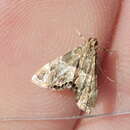en
names in breadcrumbs


Usingeriessa onyxalis is a moth of the family Crambidae. It is native to southern Texas, Mexico and Central America. It is an introduced species in Hawaii.[5]
The larvae are thought to be aquatic.[5]
{{cite book}}: External link in |postscript={{cite journal}}: Cite journal requires |journal= (help) Usingeriessa onyxalis is a moth of the family Crambidae. It is native to southern Texas, Mexico and Central America. It is an introduced species in Hawaii.
The larvae are thought to be aquatic.